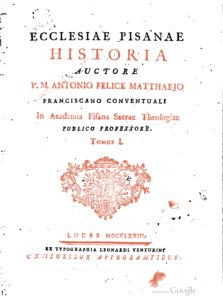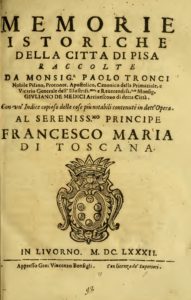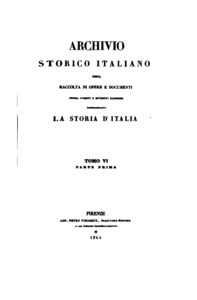Transcription
“Non devo lasciar di dire, che i Pisani al loro ritorno di Soria, messero nei loro navigli gran quantità di Terra Santa, per la quale hà poi preso il nome di Campo santo il Cimiterio fabbricato vicino al Duomo con tanta spesa, e magnificenza, come si dirà, che per sepellire i morti, non credo sia così sontuosa fabrica in tutto il Mondo, con ragione ammirata da chiunque la vede e hà una proprietà la detta Terra santa, che in brevissimo tempo consuma ancor gli ossi de’ cadaveri. Della trasportazione di essa ne dice il Volterrano, F. Leandro Alberti et altri Scrittori. Hò sentito io dire da’Vecchi della Città, che avanti, che le navi cariche di detta Terra, entrassero in Pisa, si fermorno alla riva d’Arno a canto la Chiesa di S. Giovanni al Gaetano, e che, ò pregati da’Gaetani padroni di essa, ò per volontà de’Capitani, molte corbe di detta terra furno portate avanti la porta della detta chiesa, e che quel luogo, sebene angusto, che serve per Cimiterio, partecipi delle medesimi qualità di quella del Campo santo.” (159-160)
“[1200] Mentre che i Secolari attendevano alle fabriche da guerra, gli Ecclesiastici ancora diedero principio ad un edifizio di bellezza singolare, poiché l’Arcivescovo Ubaldo Lanfranchi diede mano alla fabrica del Campo Santo per la sepoltura de’ morti, la quale fù poi ridutta a perfezione con quella magnificenza, che fà stupire chi la vede, e considera, l’anno 1277 per la parte però che risponde verso il Duomo, come in detto anno si vedrà. Dicesi, che la sua lunghezza, larghezza et altezza corrisponda all’Arca di Noè, nel che io mi rimetto alla verità. Il suo pavimento è tutto di marmo fino bianco, con numero grande di sepolture in modo, che sotto ogni quadro vi è la sua; sebene non v’è fatto il chiusino di sopra. Sonovi di più molte tombe, ò pile, come vogliamo dire, pure di marmo bianco lavorate con intagli, e figure accomodate à torno àtorno nello scoperto. Le facciate de’ muri di dentro tutte sono dipinte di mano di valentissimi Pittori di que’ tempi, con molte historie del Testamento vecchio, e vite di Santi, e processioni con Reliquie trasportate a Pisa. Nelle parti, che guardano al Campo santo sono sessanta finestre di marmo con sottili colonne, dove furono già invetriate colorite con bellissime figure. La facciata per di fuori è tutta di marmo bianco con due belle porte et è coperto il detto edificio tutto di lastre di piombo. Si disse alcuni anni indietro, che la Terra Santa, della quale è ripieno il detto Cimiterio fosse stata portata dai Pisani, quando tornorno di Palestina. Altri vogliono, chehavendo inteso il sopradetto Arcivescovo Ubaldo, che di Gerusalemme era stata portata à Roma della terra dell’Orto, nel quale fù sepolto Nostro Signore, che in spazio di tre giorni consumava i cadaveri, risolvesse anch’egli di farne venire tanta, che riempisse lo spazio dello scoperto, e che mandasse navigli in Oriente con grandissima spesa, quali tornati con la terra medesima, la facesse spargere nel Cimiterio, e l’effetto, che ne segue, manifesta la verità.” (168-169)
“[1277] La sontuosa fabrica del Campo Santo in Pisa nel presente anno si tirò molto avanti come apparisce in un marmo murato nella facciata verso il S. Giovanni à mano manca nell’entrare per la porta principale, e sebene dice 78 s’intende al Pisano, e noi per concordare generalmente con i Scrittori, scriviamo al Romano. Dice l’iscrizione
Anno MCCLXXIIX, Tempore Domini Friderici / Archiepiscopi Pisani, Domini Tarlatti Potestatis, Operario Orlando Sardella, Ioanne Magistro aedificante.
Non restò per questo finito, e perfezionato in tutto il magnifico Edifizio sino all’anno 1464 in tempo dell’Arcivescovo Filippo de’Medici, come si legge in un’altra inscrizione pure in marmo nello stipite del portone incontro la Cappella della Barbaresca, hoggi de’ Battaglini, nella faccia, che mira verso il campo. Scrissi, mi raccordo, sopra nell’anno 1200 di questo medesimo Campo Santo in tempo dell’Arcivescovo Ubaldo, per confermarm con il Volterrano, hora mi dichiaro, che ammetto, che la fabrica si cominciasse, e che si mettesse in uso di servirsene per cemeterio, mà non già che allora di finisse, perché con pace dell’antico Scrittore, le inscrizioni convincono senz’ombra di falsità. L’edifizio in questo genere è così singolare, che non hà simile in tutta Europa. È fabricato tutto di marmi candidissimi, di lunghezza di braccia dugento tredici, di larghezza sessant’uno. Nel pavimento vi sono sepolture numero seicento trenta di marmi bianchi et accanto alla faccia del campo, vi sono circa sessanta cassoni pure di marmo historiati, parte de’ quali sono stati ivi trasportati da diverse parti del mondo. Vi sono altri sepolcri di famosi Dottori; Sonovi circa sessanta finestre pure di marmi con le colonnette simili con loro architravi intagliati. I tetti sono coperti di piombo, e le facciate de’ muri di dentro dipinte da squisitissimi Pittori, de’ quali m’ è parso bene additar l’opere, acciò siano note à chi hon ne avesse cognizione. Entrando però per la porta reale, e volgendo a man dritta, vi sono dipinte l’historie de’ Santi Padri heremiti da Pietro Laureati Senese, che fiorì circa gl’anni 1336. L’Inferno lo dipinse Bernardo di Cione Orcagna Fiorentino, che fiorì circa l’anno 1400. Segue poi il Giudizio universale, diptinto da Andrea Orcagna fratel maggiore del sopradetto Bernardo, e fiorirno le sue pitture l’anno 1389. Nella compsizione del detto Giudizio adattò molte bizzarie a suo capriccio, pose in una parte una rappresentazione de’ Campi Elisi, dipingendovi molti Signori involti in piaceri mondani, assisi sopra un prato fiorito sotto l’ombra de’ aranci, che facendo amenissimi bosco, hanno sopra i rami alcuni Amoretti, che volando attorno a molte dame dipinte al naturale, hanno sembianza di saettare i loro cuori et appresso d’esse son figurati huomini, che stanno attenti a suoni, e canti, e balli, fra essi vi è il ritratto di Castruccio Signore di Lucca giovane di bellissimo aspetto, con la veste, e capuccio azzurro, con uno sparviero in pugno, e tutti quei, che gli sono a acanto rappresentano altri Signori, che vivevano in quell’età. Nella medesima historia, figura sopra un’alto monte la vita di coloro che pnetiti de’ lor peccati, desiderosi di salvare le’anime loro, hanno lasciato il mondo, e ritiratisi ivi, dove sono molti santi Romiti, che servono à Dio, altri intenti alla contemplazione et altri alla vita attiva, e da basso v’è dipinto un S. Macario, che addita à tre Re, che à cavallo sono, e vanno a caccia, per accertargli delle miserie humane, tre altri Re morti, che giacciono in sepultura non ancora del tutto consumati, in uno de’ vivi à cavallo è ritratto Uguccione della Fagiuola, che si tura il naso per non sentire il puzzore de’ morti. Nel mezzo di questa historia vi è il trionfo della Morte. Vola ella per aria vestita di nero con la falce in mano, dimostrando, che con essa hà levato la vita a molti, che giacciono per terra estinti d’ogni stato, e condizione, giovani, vecchi, maschi, e femine d’ogni età, intorno a i corpi de’ quali sono alcuni diavoli, che cavano loro di bocca l’anime, e le portano a certe bocche che vomitano foco sopra la sommità d’un altissimo monte, dall’altra parte sono Angioli, che tengono una cartella grande, dove sono scritte queste parole: Scherno di sapere, e di richezze, e di nobiltade ancora, e di prodezze, val niente al colpo di costei; il resto non s’intende. Nella storia del Giudizio si vede Giesù Christo sopra le nuvole in mezzo à dodici Apostoli, e disotto da una parte i doloris effetti de’ dannati, strascinati da’ Demonj furiosamente all’Inferno, e dall’altra il giubilo de’ buoni, che da una squadra di Spiriti beati guidati da S. Michele Arcangelo sono condotti alla destra per anda a goder la gloria Celeste.
Buonamico Buffalmacco dipinse ancor lui in Campo santo un due luoghi, e per caminare con l’ordine, che habbiamo preseo, v’è di suo la Passione di Christo con numero grande di figure a piedi et a cavallo, tutte in varie, e belle attitudini, la storia della Resurrezione, e l’apparizione a gl’ Apostoli. Fu quest’huomo non solo valente nella pittura, ma graziosissimo nel parlare, e faceto. Morì l’anno 1340 in Fiorenza nell’Ospedale di S. Maria nuova, e doppo la sua morte fù chi scrisse di lui questi due versi.
Ut MANIMVS nemo melius formasse figuras, / Sic poterat nemo vel meliora loqui.
[…]
Seguono dopoi altre opere del sopradetto Buonamico Bufffalmacco, che sono alcune storie dal principi del Mondo fino alla fabbrica dell’Arca di Noè et in capo alla parete dipinse un Dio Padre, che regge con le braccia i Cieli, e tutta la machina dell’Universo, ivi sono distinte le Gerarchie, i Cieli, gl’Angioli, il Zodiaco, e tutte le cose superiori, gl’Elementi, e finalmente il centro, e per empir i due angoli da basso, dipinse in uno S. Agostino, e nell’altro S. Tommaso d’Aquino. […]
Si trovano poi l’historie del pazientissimo Giob tenute da molti di Giotto Fiorentino, mà secondo il parere del Vasari, sono di Taddeo Gaddi suo discepolo, che fiorì nel 1350. E perché in due quadri non si conoscevano più le pitture, furno di nuovo dipinte da Giovanni Stefano Maruscelli.
Le historie de’ Santi Martiri Efeso, e Potito, con additare la traslazione de’ loro corpi di Sardegna à Pisa, sono di mano di Luca Spinelli Aretino, che fiorì dal 1380 al 1400.
Seguono poi quelle della vita, e miracoli di San Raniero Confessore Pisano, le disopra sono di mano di Simone Memmi Senese, che fiorì nel 1345 e quelle di sotto d’Antonio Veneziano nel 1380. Del sopradetto Memmi è ancora la Madonna Santissima Assunta, sopra la Porta reale.
Il Vasari vuole, che ancora Vittore Pisano, detto il Pisanello, dipingesse il Campo santo. Io che poco m’intendo di pitture, non saprei dire quale fosse opera sua, se però non havesse fatto qualche cosa nell historie di S. Raniero, e de’ Santi Efeso, e Potito. Mi rimetto a chi s’intende dell’arte.
Fra tutti sopradetti Pittori per il comun giudizio è data la palma a Benozzo […]” (234-237).




